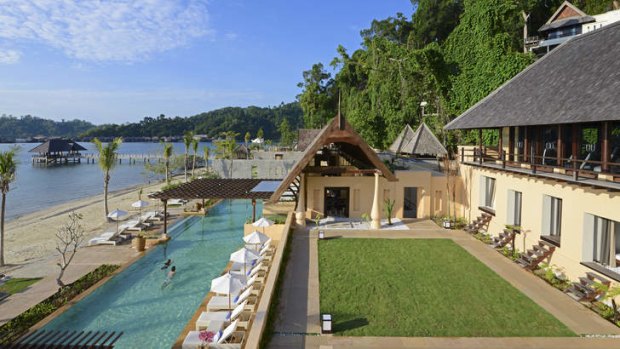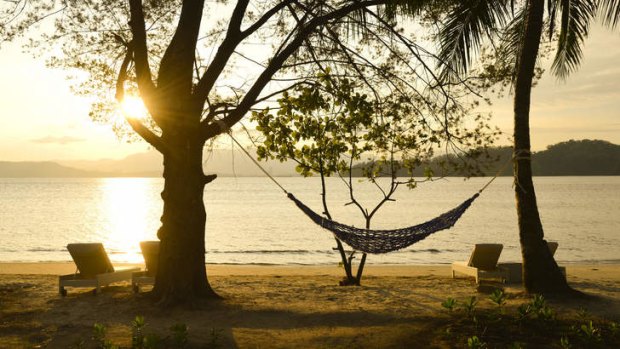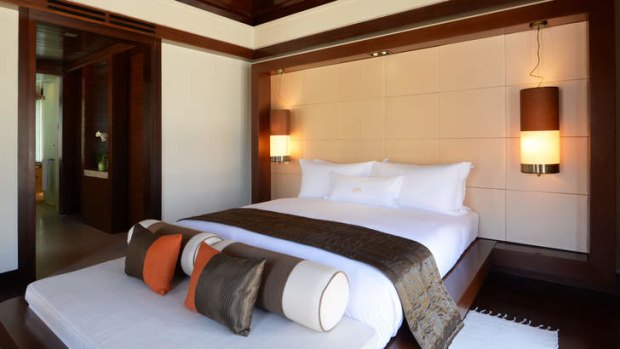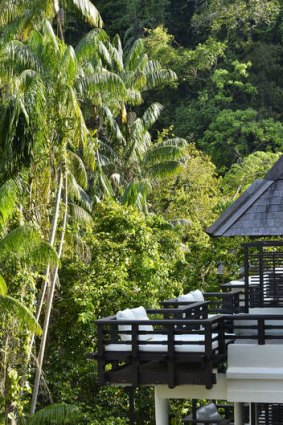
Gaya island resort.
A new island resort sets five-star comforts against the beauty of the Borneo jungle, writes Sarah Maguire.
A king tide is lapping around nearby beach loungers and umbrellas as Kirinjit Singh tells us if headhunting endured in Borneo, we would not be in danger. Those tribal warriors of infamy would be leaving us to our dinner of local prawns, scallop and lobster, skewered and grilled over hot coals a few steps from our table. A tourist at an island resort is not what the headhunters would have sought. There was nothing random about their choice of victim, resort manager Kirinjit tells us; rather, warriors in other villages were their target, and removing their heads a rite of passage to manhood.
Best, in the 21st century, to be concerned about mosquitoes and the threat of dengue fever; the repellent has been applied; fat raindrops are spitting down on us, intermittent enough for us to remain at the table, sand between our toes. The food has been cooked in the manner of the seafaring Bajau tribe - one of 32 ethnic identities in the state of Sabah - for a banquet inspired by one of its members, Mat Salleh, a folk hero responsible for the 1897 razing of the British North Borneo Chartered Company's administration centre on Gaya Island. More than a century later, here we are on that same island, just a 15-minute speed-boat ride from Sabah's capital, Kota Kinabalu, at the third and latest resort to open amid Gaya's ancient jungle. As rebellious as it gets at Gaya Island Resort is refusing the stand-up paddle boarding, deep-sea fishing and other adventure activities on offer to sip cocktails while lying in the pool on a floating cabana.

The beach at sunset.
Less than a year old, Gaya Island Resort's 121 villas climb up a hillside overlooking Malohom Bay and the coral gardens that lie beneath, part of the Tunku Abdul Rahman Marine Park. In the distance is Mount Kinabalu, a stunning sight when its jagged peak isn't hidden behind clouds.
The villas, Sabahan in style on the outside and contemporary five-star on the inside, have baths the size of small pools (there is no wanting for water in Borneo), large bedrooms, walk-in wardrobes and verandahs with daybeds. Beyond them lies virgin rainforest, where guests are advised not to venture alone. There may be cocktail bars, restaurants, a spa and a 40 metre pool, but this is still Borneo, a byword for verdant, perilous wilderness and, in the enigma stakes, up there with Timbuktu.
The resident naturalist, Justin Juhun, from the town of Tawau on Sabah's south-east coast, takes guests on walks through the jungle. He is discovering and recording the species that live in it. There are flying squirrels, proboscis monkeys, long-tailed macaques, bearded pigs, angle-headed lizards found nowhere else and 15 snake species, including the venomous waglers pit viper, a benign-looking green string of a thing that we get to see up close because it has taken up residence on one of the villa verandahs. Justin says nine out of 10 people will see no wildlife during a rainforest walk. While the jungle might keep up a 24-hour racket of chirruping insects and birdsong, its residents remain elusive. (Although, I see later, the resort literature urges guests against feeding the "sometimes very visible" monkeys and squirrels that will enter your villa if you don't take care to lock it.) There are thousands of plant species, too. As Jason points out strangler figs, money plants, macarangas and fishtail palms, it starts to rain. Again. It is pointless, apart from opening your umbrella with a certain insouciance, to take any notice.

Villa comforts.
There is sunshine as we snorkel off the resort's jetty with the resident marine biologist, American Scott Maybeck. He warns of jelly bugs in the water which might cause a "little itch" (and on which I blame a rash that shows up back in Australia) but, with rashies on, we jump in. The fringing reef, eroded by fishing practices but with a rehabilitation program led by Maybeck under way, is inside the highest biodiversity area in the world for coral and fish species - an area that includes the Great Barrier Reef. Maybeck says on any one snorkel he will see up to 50 species of fish; today our roll-call includes blue-spotted stingray, yellow box fish, raccoon butterfly fish and six-banded angelfish.
By lunchtime at the resort's Feast Village, the thunder is clapping again; soon Mount Kinabalu will disappear into mist, as will Kota Kinabalu; container ships will appear ghostly on the stretch of South China Sea between KK and the island. This is the rhythm of the wet season on Gaya: the clouds roll in, the thunder roils and lightning flashes, the rain comes and there is sunshine again, and the sea becomes a glorious blue.
Early one morning, after an overnight storm, an army of workers is about, sweeping debris off the beach, tending the gardens and cleaning the pool. "Good morning," one of the workers says. "The rain is coming."

The view from the verandah.
A good place to be when the heavens open is at the resort's Spa Village, a palatial, soaring edifice set amid mangroves. As with much else at the resort, in keeping with its "distinctively Borneo" philosophy (and branding), the spa is all about immersing guests in local nature and culture. Its treatments reflect "the healing traditions of Sabah's many indigenous peoples". As my feet soak in warm water, hibiscus flowers bobbing around my ankles, masseuse Sahajida explains it is a Sabahan custom to clean the feet before entering a home. She then performs an indigenous massage with a spicy oil of ginger, glang glang, rosemary and nutmeg, telling me she lives in KK and travels by boat each morning to work, sometimes a rough ride that scares her.
The trip to Gaya Island Resort takes its guests and workforce past a colourful floating village of stateless people, so-called "sea gypsies", some of whom also work at the resort. On our first night, as we dine at Fisherman's Cove on lobster bisque and poached trout, resort general manager Jeffrey Mong tells us the "gypsies" are a mix of Filipino refugees from Mindanao, Indonesians who came seeking work, and the descendants of Sabahans who swapped life on land for the sea rather than live under British rule.
Luke Hurford has also joined us for dinner. The Australian is the vice-president for sales and marketing for YTL Hotels, the Malaysian company behind this and many other resorts and hotels throughout Asia, including the much-lauded Pangkor Laut off Malaysia's west coast and the Surin Phuket in Thailand. Hurford says Gaya Island Resort is the perfect way for Australian travellers to wrap up a Borneo adventure holiday. "They've done the orang-utans, climbed Mount Kinabalu, white water rafted, then they come here, for relaxation."
It is also a relatively affordable fly-and-flop holiday if you want to head straight there, but there's no lack of activities. You can tour the four other islands in the marine park, take a diving course, head over to KK for guided tours of villages, markets and countryside or, back at the resort's Pure Activity Centre, try your hand at weaving in the way of the Kadazan tribe, or beadwork in the way of the Rungus. For children, there is the Kuri-Kuri Kids Club, with an emphasis on creative games and education about the island's nature.
In fact, good luck fitting in the flopping.
Sarah Maguire is editor of Traveller. She travelled courtesy of Malaysia Airlines and YTL Hotels.
THREE MORE RESORT DIVERSIONS
Sail into the sunset For 250 ringgit ($85) a head plus tax, take a sunset cruise on board the resort's 19.5-metre yacht, the Lumba Lumba. You'll be served wine and nibbles while admiring the pink-hued end of the day and, if you're lucky as we were, twin rainbows disappearing behind an islet in the South China Sea.
Food fun At the Borneo Culinary Journey, you have your own workstation and cooktop for preparing, under the guidance of resort chefs, dishes such as cured snapper, a Kadazan recipe, and chicken in grated coconut, from the Iranun people. And you'll be presented with a certificate while eating your spoils for lunch. 180 ringgit a head plus tax.
Stories to tell Local tales and folklore of Sabah's ethnic groups are imparted in daily storytelling sessions at the Pure Activity Centre. There are also thrice-weekly performances of Borneo dance styles, at which guests are invited to have a go. Both are complimentary.
FAST FACTS
Getting there Malaysia Airlines has a fare to Kota Kinabalu for about $820 low-season return from Sydney and Melbourne, including taxes. Fly to Kuala Lumpur (about 8hr) and then to Kota Kinabalu (2hr 35min); see malaysiaairlines.com. The resort provides transfers from the airport to Sutera Harbour Marina in KK (110 ringgit ($38) for a three-seater vehicle), where you'll be checked in to the resort before transfer to Gaya Island by speedboat (140 ringgit a person).
Staying there Villas start from 710 ringgit a night including breakfast, plus charges and taxes. The villas are 47 square metres; prices vary according to the view. There is one two-level, two-bedroom suite available from 2600 ringgit a night. Sabah parks levies a 20 ringgit-a-night conservation fee per guest. The rooms have complimentary wi-fi and a television with satellite channels. See www.gayaislandresort.com.
When to go Wet season (which has its own charms) is November to March; dry season is April to October.
Sign up for the Traveller Deals newsletter
Get exclusive travel deals delivered straight to your inbox. Sign up now.